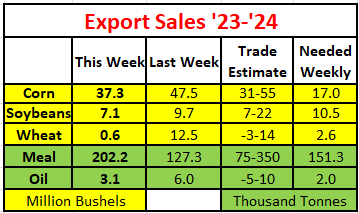It was another day of choppy trade, with mixed results. Corn futures finished higher. May corn closed 3 1/2 cents higher, settling above the 10 and 40 day Moving Average. December corn settled a couple cents higher at $4.73. A rally in meal helped beans bounce a dime off session lows. May soybeans finished the day down 2 cents, with November prices slipping a penny lower. Wheat prices were all over the place. Nearby Chicago closed 1/4 cent higher, KC down 3 cents and MPLS up nearly 7 cents.
Fed Chairman Powell said the Feds will take a wait and see approach regarding interest rates. He also said interest rate cuts are likely. The timing is key, and some other board members have commented that they don’t see a cut until 4th quarter. But, Wall Street has the jitters regarding a rate cut. The Dow dropped 530 points today and gold fell $4.60. Oil rallied $1.42/barrel with the dollar index unchanged.
Export sales were on the lower end of the trade estimate for corn, soybeans and wheat. If this pace continues, corn and soybeans may struggle to hit the USDA’s export goal. However, there were a couple of bright spots with regard to exports today. The USDA announced a flash sale of 5.6 mbu of soybeans to Mexico. Corn shipments hit a marketing year high of 64.6 mbu. At least we are shipping bushels that are on the books…..
Bird flu is making its rounds in the US again. That is a demand killer for corn. Did you know that the USDA paid poultry producers over a half billion dollars last year to kill turkeys, chickens and egg-laying hens with the flu strain (H5N1) on their farms? The government pays for birds killed through culling, not those that die from the disease. The reasoning, per the USDA, is that producers are more apt to limit the virus’s spread to nearby farms if they are paid to be pro-active in outbreaks.
The USDA will release the April Supply & Demand report next Wednesday. The government will make adjustments based on the Stocks report last week and current demand. It is probably too early for the USDA to adjust feed demand based on recent bird flu cases. The April report is always interesting given the surprises from the March Stocks numbers.
As we mentioned yesterday, the trade is not buying the loss of acres for 2024. Fair enough. We will wait til June to see the numbers. We thought it would be useful to see how different crop scenarios stack up with regard to profitability. Purdue recently updated their Cost and Return Guide for crops. It ain’t pretty. From a purely net income point of view, everyone loses money in the scenarios below, using Purdue’s costs.
Planting soybeans this year appears to be the winning strategy, if you consider losing $48/acre winning. Rotation corn yields a $152/a loss at $4.50 cash prices. Thinking back to the March report, is it really a stretch to assume that we lost so many corn acres this year? Losing $150/a adds up pretty quick on a 1,000 acre corn farm. 
On the other hand, we are a long way from putting the crop in the bin. Many things can drive prices higher (planting delay, safrinha crop issues, Greet policy, adverse US weather, etc). And, many things can drive prices lower (WW3, China tariffs,etc). Nothing is set in stone.
If you pushed corn prices to $5 with a 190 bpa yield, you “only” lose $57 acre. Push soybean prices to $12 with a 58 bpa yield, and you lose $22 acre. The point is that even if you are not thrilled with $5 and $12 prices, it is important to sell some at those levels to limit your loss.
Good night.
Disclaimer: This material should be construed as market commentary, merely observing economic, political and/or market conditions, and not intended to refer to any particular trading strategy, promotional element or quality of service provided by AgriSource Inc. Information contained herein was obtained from sources believed to be reliable, but is not guaranteed as to its accuracy. These materials represent the opinions and viewpoints of the author, and do not necessarily reflect the viewpoints and trading strategies employed by AgriSource, Inc.
AgriSource, Inc. is not responsible for any redistribution of this material by third parties, or any trading decisions taken by persons not intended to view this material. It does not constitute an individualized recommendation, or take into account the particular trading objectives, financial situations, or needs of individual customers. Contact AgriSource, Inc. designated personnel for specific trading advice to meet your trading preferences or goals.


